Southampton, Ontario
Southampton is a community on the shores of Lake Huron in Bruce County, Ontario, Canada and close to Port Elgin. It is located at the mouth of the Saugeen River. The size of the town is 6.44 square kilometres. The permanent population in 2016 was 3,678 but the summer population is higher, due to cottagers and campers spending vacation time in the area.[1]
Southampton | |
|---|---|
Community | |
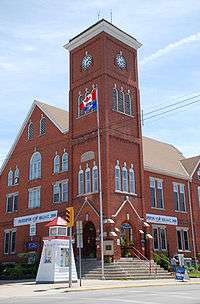 View of 201 High Street, the traditional Town Hall. | |
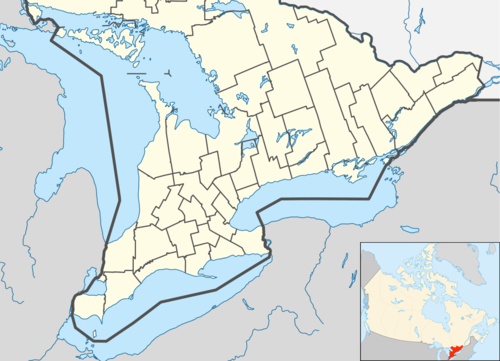 Southampton Location in southern Ontario | |
| Coordinates: 44.500°N 81.367°W | |
| Country | |
| Province | |
| County | Bruce |
| Town | Saugeen Shores |
| Government | |
| • Type | Municipal |
| Time zone | UTC-5 (EST) |
| • Summer (DST) | UTC-4 (EDT) |
| Area code(s) | 519 |
Although the community still has its own post office, and road signs indicating the name Southampton, it is no longer an entity, per se. In 1998, Port Elgin, Southampton and Township of Saugeen, all along the shores of Lake Huron, were amalgamated to form the Town of Port Elgin-Saugeen-Southampton. On December 17, 1998, the Province renamed the community the Town of Saugeen Shores.[2] The primary employment categories are agriculture, small business, tourism and the Bruce Power nuclear power station which is 40 kilometres away. Southampton is a bedroom community, a retirement destination, as well as a tourist destination.[3]
History
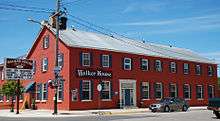
Long before settlers arrived to the area, Southampton was an important trading area, according to a historic plaque erected in town by the Government of Ontario, titled Fur Trading at Saugeen:
The Anishnabe lived by the mouth of the Saugeen River before Pierre Piché arrived in 1818 to begin fur trading in the region. By 1826, the Hudson's Bay Company established an outpost at Saguingue to compete with independent fur traders like Piché. From La Cloche, its main post on Lake Huron, the Hudson's Bay Company employed First Nations, Métis, French, and British fur traders who largely depended on Anishnabe hunters to supply deer, bear and marten skins. By 1832, the supply of premium furs was exhausted and the company closed its post. Although many Anishnabe gave up hunting and settled in an agricultural village, fur trading continued here until the mid-19th century when Southampton was founded."[4]
The community was originally known as Saugeen by the early residents, by the Canadian Post Office and by Custom House Departments. However, the Crown Land Departments labelled the village as Southampton and the name stuck as the town was incorporated, named after Southampton, the English sea port. The first European settlers of the area, around 1848, were Captain John Spence and William Kennedy, who wanted to establish a fishing company.[5]
While it proved unfruitful, Spence became a sailor and Kennedy joined a search for the Arctic explorer, Sir John Franklin. Nevertheless, in 1851 there were at least a dozen families living in the community.[6] In the same year, the Post Office was established, the first and only in Bruce County for several years.[5] Three years later, a Bank of Upper Canada was built.
In 1846, Smith's Canadian Gazetteer describes Saugeen (Southampton) as little more than a pioneer settlement:
A Settlement of Chippewa Indians, near the month of the Saugeen River, on Lake Huron. ... Sir F. Head, in 1836, obtained a surrender of that vast tract of land ... containing about 1,600,000 acres. ... There are some good log houses, and several comfortable bark shanties. On the hill, in rear of the flats, are several fine fields of corn and potatoes. ... The fishing is very productive, and has attracted the notice of the white people ...[7]
The pioneers of Southampton wanted the village to become the county town or county seat, as the village held the only Crown Land Department and Post Office in the county. However, the town of Kincardine had a larger population and seemed the strongest rival. Furthermore, Southampton did not have enough population to meet the requirements for incorporation. The town petitioned the Legislative Assembly of Ontario and the elective officials passed an exceptional Act of Incorporation on July 24, 1858 to allow the community to be considered for the county seat. Despite their efforts, Walkerton eventually won the battle.[8]
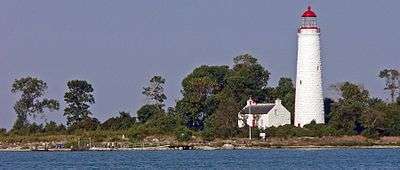
In the mid-1800s, John Denny built a dam, a grist mill, a sawmill, a woolen mill and an inn on the Saugeen River. (Only the latter building remains at 484 Carlisle Street; the current dam was built in the 1970s.)[9]
The Chantry Island Lightstation Tower was completed in April 1859, first lit on April 1, with Duncan McGregor Lambert as the first keeper.[10] (The tower and the keeper's home have been extensively renovated and are open for tours, several days a week late May to mid-September, operated only by the Marine Heritage Society. Otherwise, access to the island is prohibited because it is a federal bird sanctuary.)[11][12]
Records from 1869 indicate that the population had increased to 600. Large amount of wheat, pork and lumber were being shipped from the village. A bank agency was operating. Good roads were available to other communities. A steam ship made runs to Goderich and Collingwood in summer; stagecoaches operated in winter.[13]
Southampton was incorporated as a town in 1904; at the time, its population was over 2400. The economic base included commercial fishing, warehousing, furniture factories, a tannery and mills.[14]
The town built a hospital in 1947, a post office in 1952, a library in 1956, an arena in 1961 (replaced in 1977) and a new firehall in 1974.[15]
In the early 2000s, a historically significant shipwreck was discovered on the beach. Relics of the ship, "General Hunter," can be found in the Bruce County Museum.
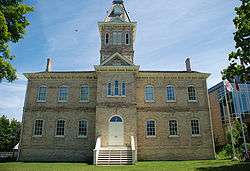
Historical timeline, 1848 to 1904
Although specific dates vary depending on the source, the following are excerpted from a reliable source, History of the County of Bruce, Ontario, Canada, by Norman Robertson, published in 1906.[16]
- 1848: The first settlement by Capt. John Spence and William Kennedy,
- 1851: First post-office, known as Saugeen, opens.
- 1852: First school opens in the village.
- 1853: First manufacturing industry was a steam sawmill.
- 1857: Denny's grist mill is already operating; he would add a grist mill in 1857, a sawmill in 1859 and a woolen mill in 1865.
- 1857: The village has over 130 houses; the business area is north of High Street, on Huron and Grosvenor Streets. There is a planning mill, a steam sawmill, and a saw and grist mill. There is no large pier but each warehouse has a landing wharf. A large pier would be built in the 1860s, called the Bogus Dock.[16]
- 1858: An Act of incorporation is passed July 24 making Saugeen a village.
- 1859: The Chantry Island Lightstation Tower is first illuminated on 1 April.
- 1880: A large tannery is opened by Bowman & Zinkan.
- 1885: Commercial fishing has grown, now employing 70 men, manning 18 boats. Steam boats are starting to become common.
- 1886: A fire in November destroys over fifty buildings. 1889 or 1890: Post office is renamed Southampton.
- 1895: As a port of entry, Saugeen is changed to Southampton. The Knechtel family begins opening large furniture factories.
- 1897: Saugeen Electric Light and Power Company begins providing electricity from Denny's dam.
- 1889: First bridge (430 feet long) at the mouth of the Saugeen River is completed.
- 1903: A smaller lighthouse, with front and back "range" lights and foghorn, opens at the harbour at the mouth of the river.[17]
- 1904: Southampton is incorporated a town on December 26; the population is over 2400. Alexander Emerson Belcher is the first mayor.[16]
Climate
| Climate data for Southampton | |||||||||||||
|---|---|---|---|---|---|---|---|---|---|---|---|---|---|
| Month | Jan | Feb | Mar | Apr | May | Jun | Jul | Aug | Sep | Oct | Nov | Dec | Year |
| Record high °C (°F) | 18.9 (66.0) |
15.0 (59.0) |
25.6 (78.1) |
27.8 (82.0) |
32.2 (90.0) |
34.4 (93.9) |
35.6 (96.1) |
35.6 (96.1) |
35.0 (95.0) |
30.0 (86.0) |
25.0 (77.0) |
18.3 (64.9) |
35.6 (96.1) |
| Average high °C (°F) | −2.7 (27.1) |
−2.6 (27.3) |
2.5 (36.5) |
9.2 (48.6) |
15.6 (60.1) |
20.7 (69.3) |
22.8 (73.0) |
22.3 (72.1) |
18.8 (65.8) |
13.3 (55.9) |
6.7 (44.1) |
0.3 (32.5) |
10.6 (51.1) |
| Daily mean °C (°F) | −6.3 (20.7) |
−6.6 (20.1) |
−1.5 (29.3) |
5.0 (41.0) |
10.8 (51.4) |
15.8 (60.4) |
18.7 (65.7) |
18.4 (65.1) |
15.1 (59.2) |
9.7 (49.5) |
3.8 (38.8) |
−2.7 (27.1) |
6.7 (44.1) |
| Average low °C (°F) | −10 (14) |
−10.8 (12.6) |
−5.6 (21.9) |
0.7 (33.3) |
5.9 (42.6) |
10.9 (51.6) |
14.5 (58.1) |
14.6 (58.3) |
11.2 (52.2) |
6.0 (42.8) |
0.8 (33.4) |
−5.9 (21.4) |
2.7 (36.9) |
| Record low °C (°F) | −32.8 (−27.0) |
−37.2 (−35.0) |
−29.4 (−20.9) |
−20 (−4) |
−5.6 (21.9) |
−1.1 (30.0) |
2.8 (37.0) |
1.1 (34.0) |
−3.3 (26.1) |
−11.1 (12.0) |
−19.4 (−2.9) |
−27.2 (−17.0) |
−37.2 (−35.0) |
| Average precipitation mm (inches) | 87.9 (3.46) |
50.1 (1.97) |
46.4 (1.83) |
53.2 (2.09) |
59.1 (2.33) |
70.6 (2.78) |
66.5 (2.62) |
82.8 (3.26) |
85.9 (3.38) |
71.2 (2.80) |
71.8 (2.83) |
83.1 (3.27) |
828.4 (32.61) |
| Average rainfall mm (inches) | 12.5 (0.49) |
13.7 (0.54) |
28.2 (1.11) |
50.0 (1.97) |
58.9 (2.32) |
70.6 (2.78) |
66.5 (2.62) |
82.8 (3.26) |
85.9 (3.38) |
70.6 (2.78) |
57.1 (2.25) |
31.5 (1.24) |
628.2 (24.73) |
| Average snowfall cm (inches) | 75.3 (29.6) |
36.4 (14.3) |
17.6 (6.9) |
3.3 (1.3) |
0.2 (0.1) |
0 (0) |
0 (0) |
0 (0) |
0 (0) |
4.2 (1.7) |
14.7 (5.8) |
51.5 (20.3) |
203.2 (80.0) |
| Average precipitation days (≥ 0.2 mm) | 16 | 12 | 9 | 10 | 10 | 11 | 8 | 10 | 12 | 14 | 14 | 15 | 140 |
| Average rainy days (≥ 0.2 mm) | 2 | 2 | 5 | 9 | 10 | 11 | 8 | 10 | 12 | 13 | 11 | 5 | 99 |
| Average snowy days (≥ 0.2 cm) | 14 | 10 | 4 | 1 | 0 | 0 | 0 | 0 | 0 | 1 | 3 | 11 | 44 |
| Source: Environment Canada[18] | |||||||||||||
Economy
Tourism drives the economy but the Bruce Nuclear plant in nearby Tiverton, Ontario is major employer. In 2016, the Bruce Nuclear Generating Station started a $13 billion refurbishment program in 2016 which will provide employment for many residents and maintain demand for other services.[19] According to Bruce Power, this multi-year plan "will generate between 1,500 and 2,500 jobs on site annually – and 18,000 across Ontario directly and indirectly – while injecting up to $4 billion annually into Ontario’s economy".[20]
Tourism
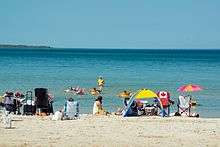
This area of the Lake Huron shore is known for its long sand beaches (the Main Beach is approximately 4 km long) as well as the sunsets since the beach area faces to the west.[21][22][23]
Every Friday night in from mid June to early September, a bagpiper plays under the "Big Flag" at the foot of High Street on Friday evenings, a tradition which started in the late 1990s. Canada Day is a highly celebrated occasion, where hundreds of cottagers and locals alike gather on Southampton Beach to watch the fireworks lit off the base of the "Big Flag". During the months of July and August there are "Ghost Walks" available every Tuesday night with Katherine Leonard & Raymond Harrison. These commence at sunset at the foot of High St at the "Big Flag". During the summer and early fall, the beaches are full of people who have come to see the colourful sunsets lighting up the sky over the lake.[22]
Near the town, Southampton, a summer destination, is close to Chantry Island, Port Elgin, Saugeen First Nation which holds a PowWow in August each year, and Sauble Beach. Every Thursday evening from early June to late August, a Cruise Nite is held; the classic cars park downtown on High St. near the lake shore. Concerts are held at Fairy Lake at least one evening per week in summer.[24]
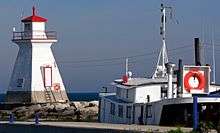
Fishing is common in this area in the nearby Saugeen River, at Denny's Dam and in Lake Huron. The Chantry Chinook Classic Salmon Derby is held each summer, usually from about mid July to the second week of August.[24] The contest's weigh stations are located in Saugeen Shores and in two other Lake Huron communities, Kincardine, Ontario, and Wiarton, Ontario.
The Bruce County Museum & Cultural Centre provides displays about local history and in summer especially, offers adult and children's programming and special events. These are listed in the Shoreline Beacon community newspaper. The museum has been enlarged over the years and was recently renovated. In addition to a settlers cabin, the facility houses numerous historic artifacts from the area, genealogical records, county newspapers, photographs, and municipal documents.[25]
During July and August, seven days a week, the S.S. Trolley shuttles passengers between downtown Port Elgin and Southampton along the roadway for a modest fee.[24]
The Chantry Island Lightstation Tower was built in 1859; the tower, keeper's cottage, boat house and dock have been fully restored. The island is a federal Migratory Bird Sanctuary and access is prohibited except with the single licensed tour operator.[26] From late-May to mid-September, tours of the lightstation facilities are available several times a week. They leave on the Marine Heritage Society's boat from the ticket office by the fishing boat docks at the harbour.
Three other local lighthouses have been designated under the Heritage Lighthouse Protection Act: McNab Point and both the Front and Rear Range lights at the River Front.[27]
Cottages
There are numerous cottage owners in and around Southampton. Cottage owners are uniquely split between those who own their land outright and those with cottages located on Native lands.[28] A lease relationship exists between the Saugeen First Nation ("Chippewas of Saugeen")[29] and cottagers who have built seasonal homes on Native land in the lakeside area between urban Southampton and Sauble Beach; there are approximately 1,200 such cottages.[30][31] Each cottager on such land pays an annual lease fee to the First Nation for use of the land.[30] The current (mid 2019) lease contract between the cottagers and two Saugeen First Nation Reserves, Chief's Point 28 and Saugeen 29, is in effect until 30 April 2021.[32]
Saugeen Rail Trail
After the railways ceased to service the area, the tracks were removed and the beds were vacant and overgrown. A group of volunteers founded the Saugeen RailTrail Association in 1990, and convinced Port Elgin, Southampton and Saugeen Township to acquire sections of the then unused rail bed. Over the years, the bed has been developed as trails for walking and cycling. The trail connects Southampton and Port Elgin. The trail also connects to the 80 kilometre long Bruce County Trail Network which leads to towns such as Paisley, Walkerton, Mildmay and Kincardine.[33] [34]
The trailhead can be accessed at River Street in Port Elgin, a few blocks north of the town centre and east of Hwy 21. There are other access points in both towns, some with parking. The trail is not groomed for cross country skiing during the winter but is used frequently for that purpose. Maps of the trails are available on the web site of the Saugeen Railtrail Association.[35]
Health care
The Town of Saugeen Shores' hospital is in Southampton, Saugeen Memorial. Many physicians' practices are at the Saugeen Shores Medical Building. The hospital is part of the Grey Bruce Health Services' network of hospitals in northern Bruce and in Grey County. According to the local Health Services department, facilities include 16 beds, a 24-hour emergency department, surgery, acute medical care and outpatient services.[36] Other facilities include:
- Chaplaincy Services
- Diagnostic Imaging Department including x-ray, ECG, Holter monitoring, ultrasound
- Inpatient Medical Care (Acute Care)
- Laboratory Services
- Physiotherapy
- Surgical Services
The hospital also houses other community health providers. Day surgery services are offered and include ear, nose and throat surgery.[37]
Retirement and assisted living
The Town of Saugeen Shores includes senior service groups and clubs as well as aid providers and senior homes that offer full services. Relevant providers include Home and Community Support Services Grey Bruce, two assisted living residences, the Hampton Court Retirement Lodge (Southampton) and Kingsway Arms at Elgin Lodge (Port Elgin) and Southampton Care Centre long term care home. Social and other services for seniors are available at PARC 55+ (Port Elgin) and Chantry Senior Centre (Southampton).[38]
Notes
- "Census Profile, 2016 Census - Southampton". StatsCan. Government of Canada. 2016. Retrieved 28 February 2017.
- "Our History". Town of Saugeen Shores. Town of Saugeen Shores. 2016. Retrieved 28 February 2017.
- "Our History". Town of Saugeen Shores. Town of Saugeen Shores. 2016. Retrieved 28 February 2017.
- Cook, Wayne (2013). "Historical Plaques of Bruce County". Wayne Cook. Wayne Cook. Retrieved 3 March 2017.
- Robertson, Norman (1906). The History of the County of Bruce. Owen Sound: Books on Demand. p. 509. ISBN 5519009104.
A comprehensive history of the county and its municipalities from the early beginnings to 1906.
- Robertson, 509.
- Smith, Wm. H. (1846). Smith's Canadian Gazetteer: Statistical and General Information respecting all parts of the Upper Province, or Canada West. Toronto: H.&W. Rowsell. pp. 165–166.
- Robertson, Norman (1906). The History of the County of Bruce. Owen Sound: Books on Demand. p. 511. ISBN 5519009104.
A comprehensive history of the county and its municipalities from the early beginnings to 1906.
- "Driving Tour" (PDF). Saugeen Shores. Town of Saugeen Shores. 2015. Retrieved 28 February 2017.
- "Chantry Island". Chantry Island, ON. Lighthouse Friends. 2014. Retrieved 28 February 2017.
Robert Mills cared for the tower’s temporary light for a season before Duncan McGregor Lambert, who had many years of maritime experience, took charge of the light in 1858. In 1854, Lambert was first mate aboard the steamer Bruce Mines, when it sank near Stokes Bay, and was largely responsible for ushering the crew into two small boats and safely seeing them to Owen Sound, a voyage of over a hundred miles.
- "About Chantry Island". Chantry Island. Marine Heritage Society.
- "About Chantry Island". Chantry Island. Marine Heritage Society. 2016. Retrieved 28 February 2017.
It is the largest Federal Migratory Bird Sanctuary between James Bay and Point Pelee. There are approximately fifty thousand birds (including chicks) on the island during the breeding season.
- McEvoy, Henry (1869). Province of Ontario Gazetteer and Directory. Toronto: Robertson & Cook. p. 433.
- "History". Southampton Residents' Association. Southampton Residents' Association. 2015. Retrieved 28 February 2017.
- "History". Southampton Residents' Association. Southampton Residents' Association. 2015. Retrieved 28 February 2017.
- "Town of Southampton". Electric Scotland. Alastair McIntyre. 2015. Retrieved 4 March 2017.
From the book History of the County of Bruce, Ontario, Canada, by Norman Robertson (1906)
- "Range Lights of Southampton". brucecoastlighthouses.com. Retrieved 19 March 2017.
- Environment Canada—Canadian Climate Normals for Southampton . Retrieved 18 March 2012.
- Learment, Frances (28 February 2017). "Bright future for Saugeen Shores". Shoreline Beacon. Southampton, Ontario. Retrieved 8 March 2017.
- "Unit 1 sets new post-refurbishment long run record". Bruce Power. Bruce Power. 14 April 2016. Retrieved 8 March 2017.
- https://visitsouthampton.ca/explore/southamptons-beaches/167/, Explore
- https://visitsouthampton.ca/profile/southampton-sunset-viewing-sunset-photography/853/, Southampton Sunset Viewing & Sunset Photography
- https://visitsouthampton.ca/profile/southampton-main-beach/801/, Main Beach
- "Attractions in Southampton". Visit Southampton. Tourist Town Online Solutions. 2016. Retrieved 27 February 2017.
- "About Us". Bruce Museum. BCM&CC. 2016. Retrieved 28 February 2017.
promotes the depth and diversity of our heritage; offers many activities that encourage meaningful reflection on the past in order to better understand the present and thus plan for the future; promotes the value of its collection and archives as a prime resource for research at all levels of learning
- "Chantry Island Lighthouse Tour". Chantry Explore the Bruce. Bruce County.
- "First designations under the Heritage Lighthouse Protection Act". Government of Canada. Government of Canada. 3 August 2012. Retrieved 29 March 2017.
- https://www.saugeenlandmgt.com/, Saugeen Land Management
- https://saugeenfirstnation.ca/, Saugeen First Nation
- https://www.theglobeandmail.com/news/national/let-us-back-into-our-cottages/article658498/, Let us back into our cottages
- https://scoi.ca/member-organizations/, Member Organizations
- https://scoi.ca/about-scoi/, Saugeen Cottager’s Organization Incorporated
- "Bruce County Rail Trail - # 17". Bruce County Trails. Bruce County Trails. 2017. Retrieved 28 February 2017.
- "Bruce County Rail Trail Map" (PDF). Bruce County Trails. Bruce County Trails. 2017. Retrieved 28 February 2017.
- "The Rail Trail". SAUGEEN RAILTRAIL ASSOCIATION. SAUGEEN RAILTRAIL ASSOCIATION. 2016. Retrieved 27 February 2017.
- "Southampton Hospital". Grey Bruce Health Services. Grey Bruce Health Services'. Retrieved 3 March 2017.
- "Southampton Hospital". Grey Bruce Health Services. Grey Bruce Health Services'. Retrieved 3 March 2017.
- "Senior Services". Saugeen Shores. Town of Saugeen Shores. 2016. Retrieved 4 March 2017.
References
- Robertson, Norman. The History of the County of Bruce. 608 pages. Owen Sound. Publisher: Book on Demand Ltd. Jan. 1, 2014. ISBN 5519009104
External links
| Wikimedia Commons has media related to Southampton, Ontario. |